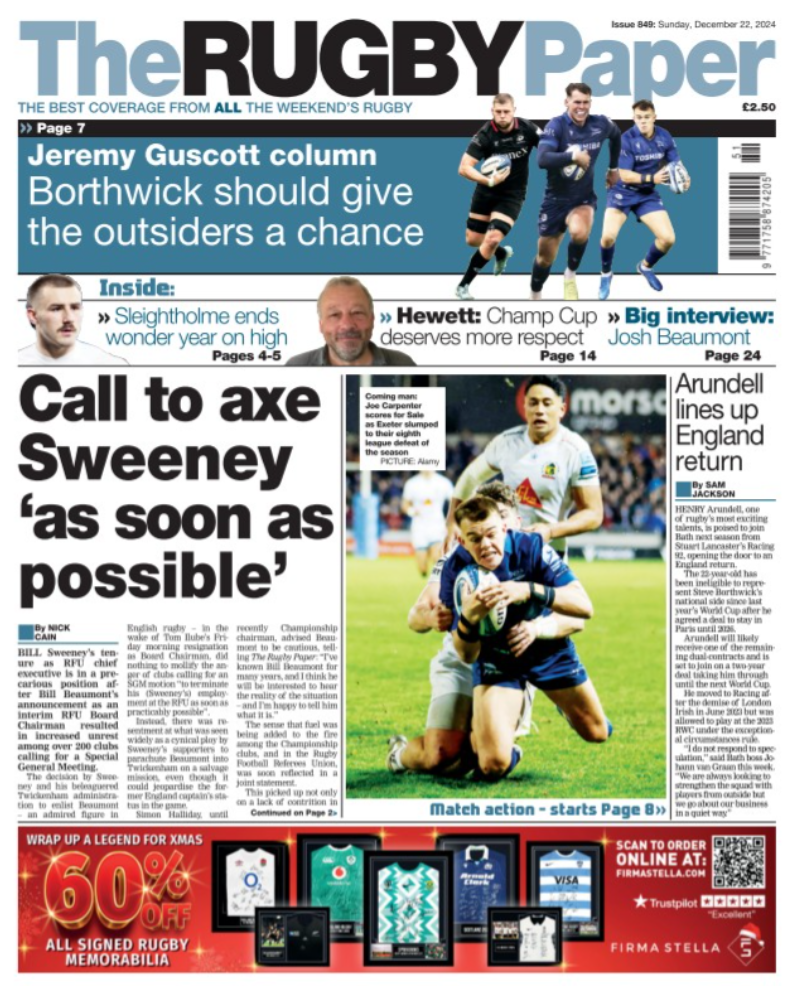Blanco exits the stage after an English shoeing

Brendan Gallagher delves into some of rugby’s most enduring images, their story and why they are still so impactful
What happening here?
It’s Saturday October 19, 1991 and England have just beaten France 19-10 after a tempestuous, violent, but nonetheless rather magnificent World Cup quarter-final at the Parc des Prince. Five or six players would have been sent off today but the law of the jungle still prevailed during this era and although the footage can appear terrifying when viewed today it was perfectly normal back then. Dr Jonathan Webb, England’s cultured full-back, is not only showing solidarity with his opposite number Serge Blanco, in a very real sense he appears to be helping him off the battlefield. The brilliant French skipper, who had announced before the tournament that he would be retiring when France either won the tournament or got knocked out, had been England’s number one target in the game and had been battered black and blue
What’s the story behind the picture?
A thousand years or more of enmity, battles and occasional grudging respect between two of the oldest rivalries on the planet, both sporting and geopolitical! At least that’s how it felt after a week of massive hype before what was undeniably a huge World Cup clash
After claiming just one win over the French between 1981 and 1988 England, under Will Carling, were beginning to get the measure of what was in fact an outstanding French side. England won 11-0 at Twickenham in 1989, claimed a brilliant and often overlooked 26-7 win at the Parc in 1990 and then sealed their first Grand Slam since 1980 when they won 21-19 at Twickenham in March 1991
That last win still rankled with France who, as anybody who attended the match will confirm, largely outplayed England and outscored them three tries to one with the try from Philippe Saint Andre still regularly making the top three in polls for the greatest try ever. My memory of travelling home from reporting that game is that it didn’t really feel like an England triumph. Strange to relate the England hero that day – full-back and deadly goal kicker Simon Hodgkinson – found himself out of favour come the World Cup.
France were itching for revenge and from a long way out it seemed likely that if England lost their opening World Cup pool game against New Zealand, the two sides would meet in the quarter-finals in Paris. This game had been on the horizon for months.
What happened next?
England absolutely blitzed the French physically in the opening salvos to intimidate Les Blues and quieten the crowd. As both France’s skipper, and still their best player, Blanco was their main target and the Biarritz full-back was savaged after bravely taking an early high ball from Rob Andrew. As he went to ground the entire England pack stampeded over him with Brian Moore and Jason Leonard making particularly painful contact. Even by the standards of the time it was brutal but with no yellow cards in operation back then and coming so early, England escaped with a simple penalty and a telling off.
France missed touch from the kick, Nigel Heslop fielded the ball and England launched another bomb directed at Blanco who called for the mark as he successfully fielded the ball. Heslop, possibly not hearing the call in the bedlam, piled into him nonetheless and bounced off Blanco’s hit, dazing himself badly in the process. A narked Blanco aimed a punch but was never into the dirty stuff and missed hopelessly although a couple of French forwards roughed up Heslop on his behalf before the Orrell wing fell to the ground. This time England were awarded the penalty and Webb opened the scoring.
Why is this picture iconic?
Because it perfectly illustrates the unwritten code of honour and fraternity that underpins rugby and makes such an intrinsically physical and violent sport possible. This is a time honoured ‘end of hostilities’ scene repeated at every level of the sport throughout the decades.
This match was one of the most brutal of a notably spicy era of the game’s history and Blanco in particular was on the receiving end but come the final whistle there are niceties that must be observed. But this moment in time goes beyond that. Like goalkeeper in football, full-back in rugby is a very exposed position and you sense that Webb is showing some heartfelt solidarity with his opposite number. Next time it could be him on the receiving end. Adding to that impression is the knowledge that Webb is, at this stage, a trainee surgeon well versed in the stresses and strains rugby can put on your body.
And the final layer of poignancy is the realisation that is was the last time Blanco was ever seen on an international rugby pitch. One of the most glorious and athletic runners in the game’s history is painfully leaving the arena, his body broken but his spirit unbowed.
Footnote: Just months after this win they met again in the Five Nations in another volcanic game at the Parc which England won 31-13 and which resulted in the sending off of Vincent Moscato and Gregoire Lascube. England were on a roll against the French and didn’t lose to Les Blues until the World Cup 3rd-4th play in 1995.
Iconic Rugby Pictures:
PART 26 Full-backs in sympatico, Serge Blanco and Jonathan Webb Oct 19, 1991